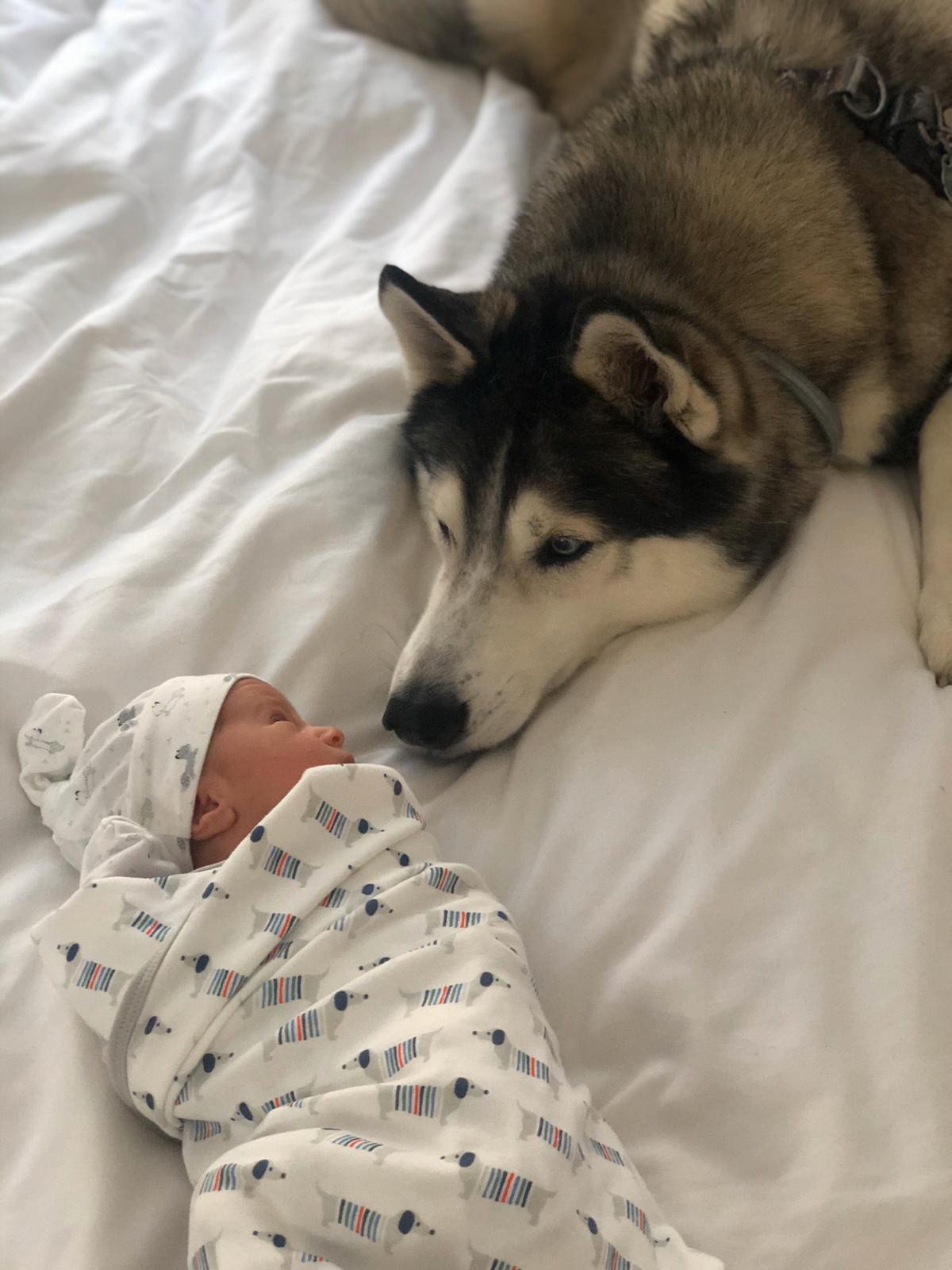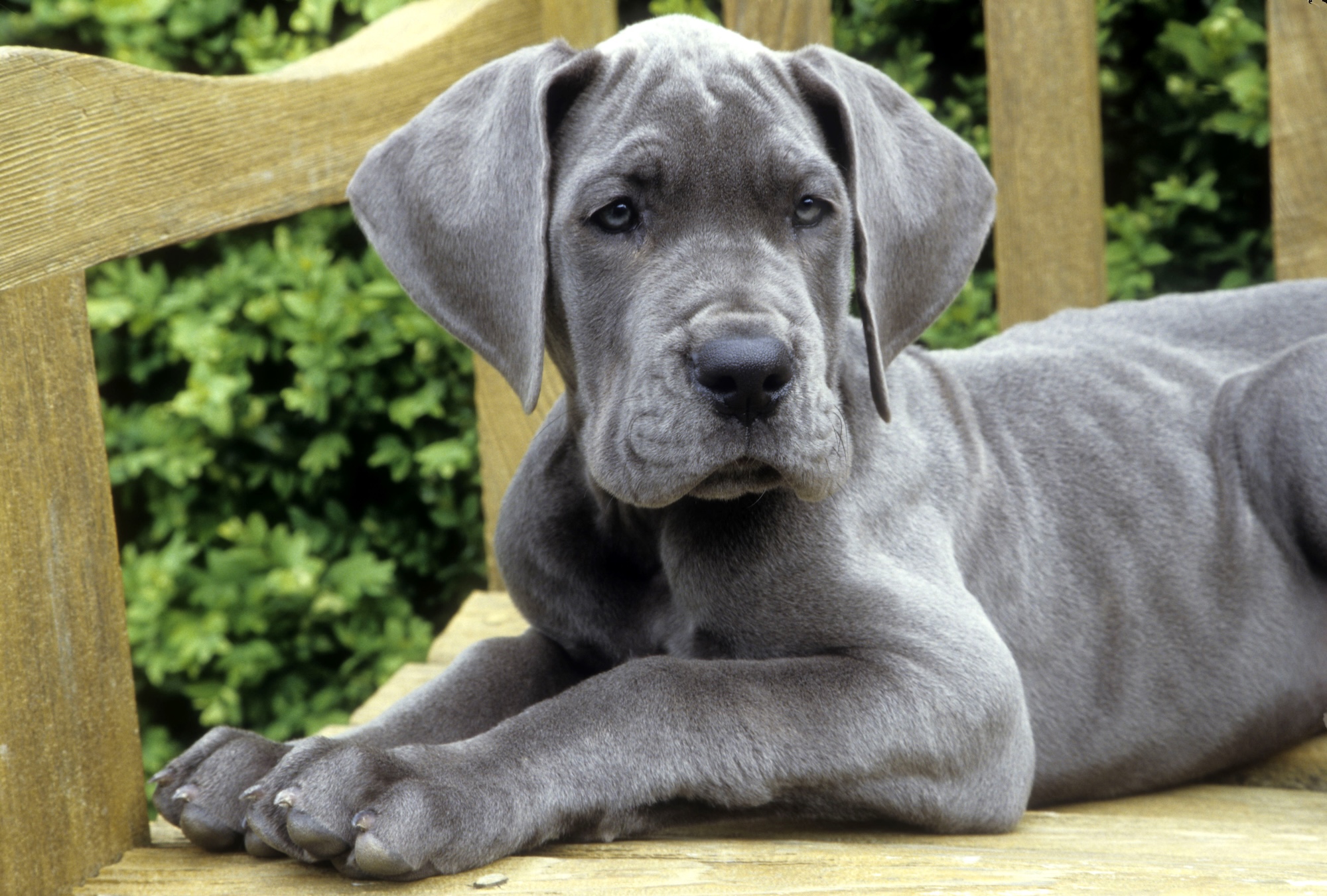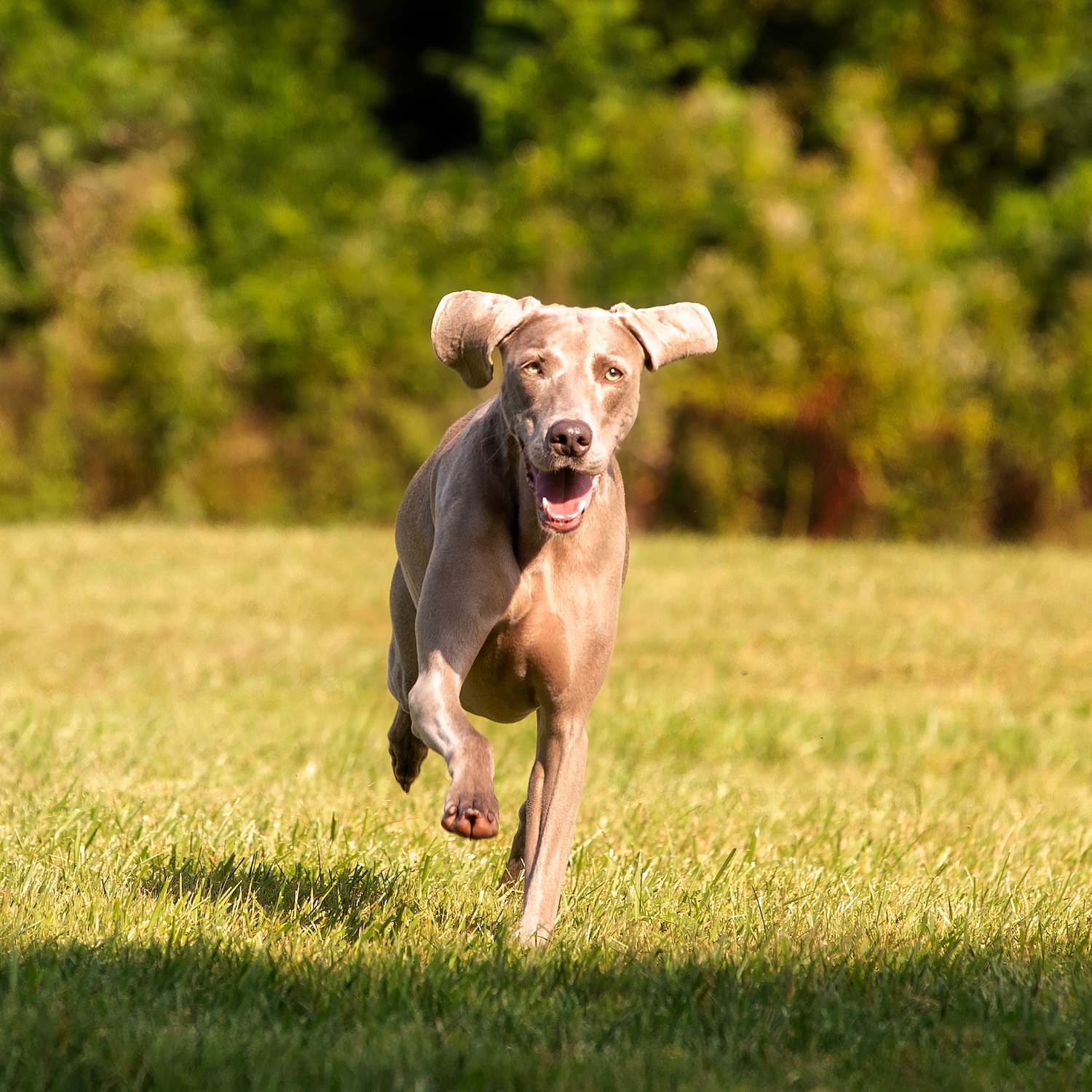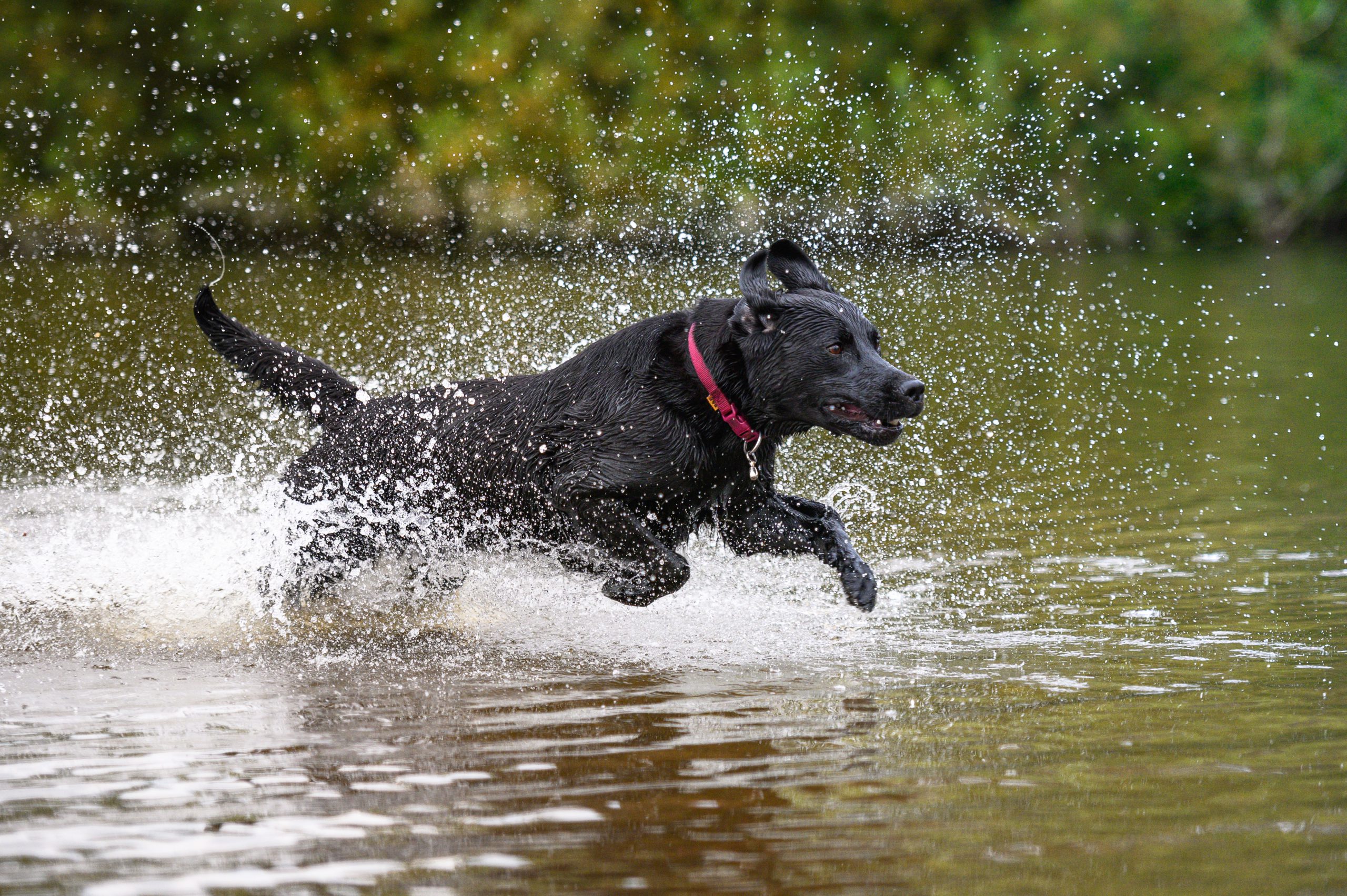Many people are attracted to Siberian huskies because of their striking appearance—they’re athletic, with dramatic coloring, thick coats, and, sometimes, ice-blue or mismatched blue and brown eyes. Huskies also charm many humans with their demeanor. Their intelligence and outgoing, active nature can make them great partners for playtime and outdoor adventures.
However, huskies, and husky mixes, can be challenging for novice dog owners or those who prefer a canine companion with maximum chill. From the amount of daily exercise they need and their unique personalities, to the type of food they thrive on, there are many things for a prospective dog owner to know before deciding to care for a husky or husky mix.
Here, we delve into some useful information and advice for husky admirers, and prospective owners.
Keep in mind that despite common breed characteristics and generalities, all dogs are individuals, shaped by unique genetics, life histories, personalities, and environmental factors. Be attentive to what your dog is telling you about their needs!
Basic breed facts
Siberian huskies originated in northeastern Asia. The husky is considered one of a small number of ancient breeds, and in fact, says Nelson Hodges, trainer and founder of the Canine Human Relationship Institute, the oldest.
As endurance sled dogs, they carried light loads over long distances in extreme cold with minimal food. This working dog breed became famous for its role in rescuing the town of Nome, Alaska from a 1925 diphtheria outbreak. A renowned musher and his team of Siberian huskies were celebrated as heroes after racing to Nome with a lifesaving treatment, traveling well over 600 miles in just five and a half days. Some of those dogs, including Balto and Togo, have statues and even films dedicated to them.
Female Huskies are usually around 20 to 22 inches tall, while males tend to stand one to two inches taller. Females usually weigh anywhere from 35 to 50 pounds; males are typically about 10 pounds heavier. But that’s just a starting point. There are all kinds of husky mixes representing a range of sizes and looks, but if there’s some Siberian husky involved, you’re probably dealing with an active, intelligent dog. And that leads to another fact to keep in mind: Sadly, shelters have seen a surge in huskies as more people (perhaps enticed by a certain winter-themed TV program) fall in love with that stunning look but don’t realize the level of attention required to live happily with this spirited dog.
This is all the more reason to spend some time learning about living with this breed. And if the time is right, consider looking for your new friend in a shelter in your area.
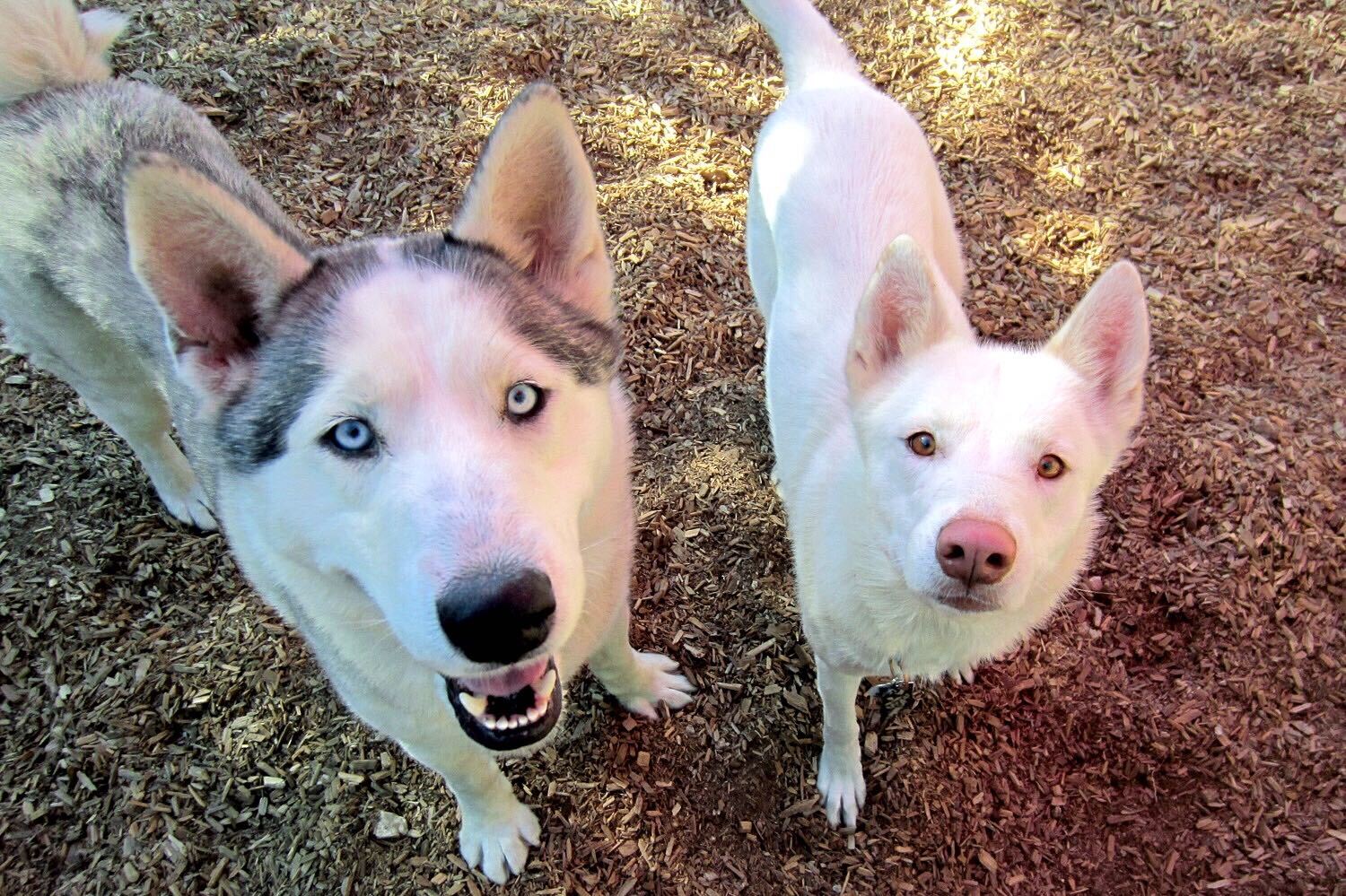
Typical personality profile
According to the Siberian Husky Club of America, a husky’s “independent spirit may at times challenge your ingenuity,” and their “predatory instincts…are strong.”
It’s common to hear huskies described as “mischievous” and “always on the go, with a keen eye for adventure.”
As in humans, high energy and a sense of adventure can be attractive qualities when they’re harnessed for constructive purposes. But these qualities can also lead to restlessness or destructive behavior if the dogs don’t get enough mental and physical stimulation. For these reasons, it’s important that husky owners understand the crucial importance of fostering a healthy lifestyle that’s suited to this breed. This lifestyle should include lots of mental and social stimulation, daily exercise, and playtime. If they get the appropriate care, Siberian huskies and husky mixes make wonderful and happy family dogs.
If they aren’t well-trained and provided with that social, physical, and mental stimulation, husky behavior can be challenging in a variety of ways. This can include digging; “escape artistry;” carrying, chewing, and destroying objects; separation anxiety; and strong prey instincts around smaller animals. It’s not uncommon for husky owners to be “gifted” small, dead animals such as frogs, mice, or even squirrels.
Hodges says it’s important to remember huskies’ background and to see their behavior from their point of view. “With Siberian huskies, you have to understand their mentality—they survived the harshest climate on earth for 30 millennia by testing each other and by testing their human compatriots each day to survive,” he says. “Survival of the species was more important than survival of the individual.”
Huskies are extremely family-oriented dogs, and they consider the miles that surround their homes their territory, which is one of the main reasons for the breed being notoriously referred to as escape artists,” says Blake Rodriguez, trainer and founder of Dream Come True K9 in New York.
As Hodges notes, huskies are extremely intelligent and they’ll figure things out without having to be shown or told. “That’s why they’re ‘escape artists’ and people say ‘hide your car keys or else they’ll take it for a joy ride,'” says Hodges. “They’ll figure out what’s important to them and they’ll figure out how to do things. They require mental exercise or they’ll find a way to exercise themselves mentally. That’s when people misunderstand and the dog gets in trouble for being a ‘bad dog.’ It’s not a bad dog or a good dog—it’s just a dog being a dog.
Training, exercise, and, crucially, mental stimulation, are highly recommended.
According to the Siberian Husky Club of Canada, in order for huskies to live peacefully and safely with cats, it’s wise to raise huskies with them from puppyhood.
Huskies also don’t bark much, generally. Instead, of course, they prefer to howl.
Jodi Eckberg, organizer of the Empire State Snow Dog Club, reports that her four huskies howl—or as she puts it, sing—at specific times throughout the day. “One of the most beautiful behaviors my boys have is when one howls, they all howl, and they sing me the most beautiful song,” Eckberg explains. “Two times each day, my boy Tsar starts the song, then Cain, Ollie, and Eros join him. This will go on for at least two minutes before they stop.”
Prone to pulling (and expressing opinions)
All dogs require some dedicated training to be good walking companions, but huskies may require a little extra attention in this area, as pulling comes naturally to them. “I knew [huskies] were diggers and could run for miles if they ever got out and weren’t trained,” Eckberg says. “But they are also pullers and normally don’t walk nicely on a leash. My boys pull like they are pulling a thousand pounds of weights, [so] I use a hip belt to walk them so I can use my whole body to pull back and walk them instead of them dragging me.”
Eckberg isn’t the only husky owner who swears by the hip belt. Lisa Der, a member of the Empire State Snow Dog Club, says purchasing the hip belt was a game-changer.
Der describes her husky as an “attention-grabber.” “He is extremely friendly, extremely fast, and he makes the funniest faces,” she says. “He loves to sit on my stoop every day for a long time, watching traffic. He senses when you are upset and will cuddle next to you and comfort you.”
Der actually rescued her husky from her son, a recent college graduate living in Florida. “He thought it was going to solve his problems of being lonely when he was transferred there right after college,” Der says. But they quickly found out a husky wasn’t the right breed for a first-time dog owner living alone. “Even though I love my husky now, (they) take an enormous amount of time and commitment,” she says.
Husky owner Anahid Kaprielian says her husky mix Noushig (pictured below) is highly intelligent, friendly, and loves being outside. Especially in the snow. She also calls her “super moody,” and a dog who “loves to argue when she does not want to do something.”
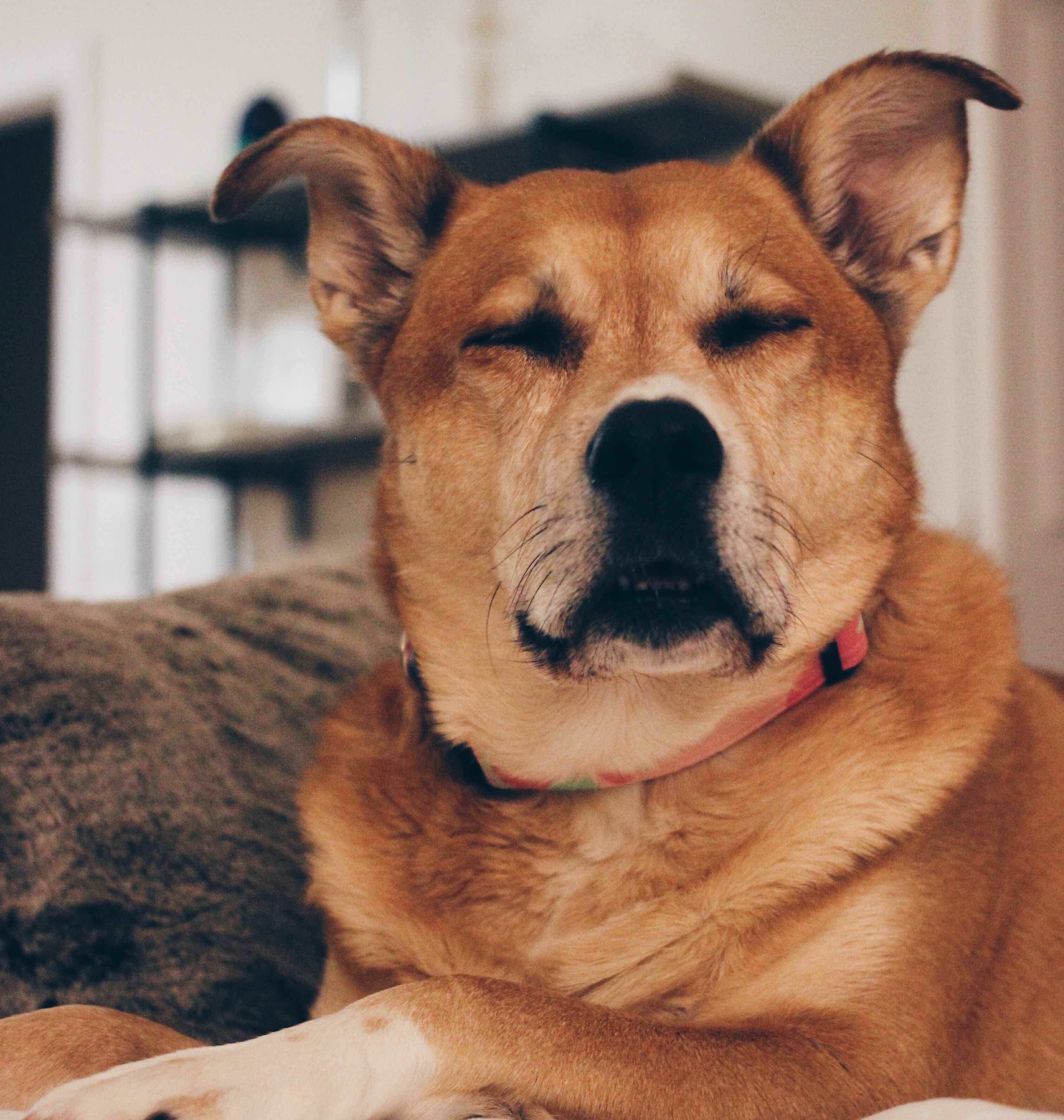
Der adds that huskies will frequently test their owners. “They are extremely smart. They will bring you your own shoes if every other hint in the world doesn’t make you get up to take them for a walk,” Der says. “And every Friday we go to get ice cream and we have to get him his own. If we do not, he will tap us on the shoulder the entire time.”
Other husky owners echo this sentiment. “He is incredibly smart, yet stubborn,” says Katie Walsh, whose husky’s name is Oakley (pictured below). “He’ll fetch if he wants to fetch, otherwise he’ll look at you like he couldn’t be bothered to do such a thing.” However, she says, “he breaks many husky stereotypes, like the inability to be off leash. He thrives off leash and I think it’s important to allow him to earn that freedom. For a husky he has great recall.”
Husky coats
Many people are drawn to the husky for their gorgeous coats. Siberian huskies have what is known as a double coat, and each layer serves a purpose in keeping the dog warm or cool. The top coat is made up of thick guard hairs that provide protection for the coat and skin. The undercoat is the soft layer made up of shorter, crimped hairs with a hollow core, which makes them good at trapping air. husky coats should never be shaved, except in medical emergencies.
With a beautiful, full coat comes a lot of heavy shedding, especially during seasonal periods and in warmer climates (“I wish I understood just how much he sheds…” says Walsh). So, if you choose to adopt a husky, be equipped with a good vacuum. On the positive side, Siberian huskies are naturally low in doggy odor. Huskies are generally very good at self-cleaning and therefore, are not particularly stinky.
Healthy lifestyles for Siberian huskies
Home environment
Many trainers recommend finding ways to direct huskies’ adventurousness and high energy rather than trying to stop it entirely. For example, a designated, supervised, digging spot in the yard (that you keep an eye on for escape routes) can offer your dog a constructive outlet for their instincts.
Exercise and inclusion in dog and human socializing are also very important as positive outlets for your husky’s high energy levels, so they tend to do best in homes with more than one dog and where human company is frequent. Mental stimulation is crucial. As Hodges notes, the notion that “if you can just give them enough exercise then they’ll be happy” doesn’t hold up for huskies. “You can’t out-exercise a husky unless you can pull six times your weight 100 miles a day and love it,” he says.
On paper, this breed is not well-suited to apartment living, but this lifestyle can work if your husky is incorporated into a regular outdoor activity and provided with ample mental stimulation.
Howling may not be appreciated by neighbors in close quarters. Training can help with this.
Breed-specific health concerns
Huskies, like any other dogs, have predispositions to certain genetically linked health issues, but with good care, they can live healthy and happy lives. Many husky people, like Noushig’s and Oakley’s owners, report no major health issues. “Fortunately, Oakley has been a very healthy pup,” says Walsh.
The health issues some Huskies may be prone to are as follows:
Cancer: Huskies are particularly susceptible to developing basal cell tumors, sebaceous gland tumors, hemangiopericytomas, a type of sarcoma that develops in the capillaries, and anal gland tumors, the risk for which can be reduced with neutering.
Degenerative myelopathy: This progressive neurological disease can first show up as weakness in the hind legs. There is no cure but various treatments, such as vitamin supplementation and physical therapy, can help with symptom relief. Degenerative myelopathy is similar to Lou Gehrig’s disease or ALS in humans.
Eye diseases: Cataracts, glaucoma, pannus, progressive retinal atrophy and corneal dystrophy are several issues to look out for. While huskies are prone to heterochromia—a difference in coloration of the irises, most commonly resulting in two different eye colors— this trait does not pose any health issues.
Stefan Leslie has learned about heterochromia since adopting his three-year-old husky mix, Astra, who is now a therapy dog. Astra, who is a husky, Chow Chow, and White Swiss shepherd mix, has a specific type of heterochromia called sectoral (or segmental) heterochromia, meaning that her one eye is blue, while her other eye is mainly brown, but also has specks of blue in the iris as well. “There have been no issues with her vision and we commonly get asked at the hospital [during therapy dog visits] if she can see from both eyes or if she is blind,” Leslie says.
Claudine Sievert, DVM, and veterinary consultant, says that huskies are prone to heterochromia due to genetics. “Huskies are genetically predisposed to congenital heterochromia because they carry the genes regulating the high expression of non-pigment. For this reason, about 40% of Huskies have blue eyes, and around 15% end up with heterochromia.”
While heterochromia is not associated with any increase in health risks, all husky owners should take note of any changes that occur in their dog’s eyes. If you notice changes or that your dog seems uncomfortable, bring your husky to the vet for an eye exam. Some eye conditions that can cause eye color to change include cataracts, corneal dystrophy, and glaucoma, so it’s best to get it checked out.
Hip and elbow dysplasia: Dysplasia describes a joint malformation that over time can lead to chronic inflammation and arthritis. Large-breed dogs are more vulnerable to this joint health problem. Hip dysplasia symptoms are similar to those of human arthritis, including pain and difficulty or hesitation in getting up from a lying position. Keeping your dog fit and avoiding obesity is crucial in staving off this issue or reducing symptoms since more weight on a joint exacerbates problems. Fresh, precisely portioned food can help with this, and foods free of potentially harmful additives can also help minimize inflammation. Glucosamine and chondroitin supplements may help relieve symptoms for dogs with hip dysplasia.
Hypothyroidism: This is a treatable hormone deficiency which has symptoms including fur loss, dry skin and coat, behavior changes indicating distress, and weight gain.
Inflammatory bowel disease: Chronic vomiting and diarrhea are signs of inflammatory bowel disease (IBD), which is fairly common in Siberian huskies. Stress and changes in diet can exacerbate symptoms of IBD, but carefully managing your dog’s diet and lifestyle can help alleviate symptoms.
Skin problems Huskies have elevated risk for several skin health issues, including zinc-responsive dermatosis, uveodermatologic syndrome, and pemphigus foliaceus. These can cause dry, crusty, irritated skin, and lead to infection. Zinc-responsive dermatosis can be treated with zinc dietary supplements, which should be administered only under a vet’s supervision and only if they have this condition. As the VCA Animal Hospital also notes, it’s important to ensure that your dog’s food contains adequate levels of bioavailable zinc, which means eliminating low-quality processed dog food. The other conditions are autoimmune disorders that are worsened by sunlight exposure, so a natural, veterinarian-approved (zinc-free) sunscreen can help. Dr. Sievert says huskies can also develop a “snow nose,” which is a temporary loss of pigment and she recommends that owners always have a bottle of dog sunscreen to prevent sunburn.
Spontaneous Pneumothorax: This refers to the sudden onset of a collapsed lung; spontaneous pneumothorax most often happens because of a collection of air in the space surrounding the lungs.
Eckberg lost her five-and-a-half year old husky, Thor, to spontaneous pneumothorax. Thor was a beloved therapy dog. “What I didn’t know was that two days earlier when I saw that [Thor’s] chest looked broader and he looked like he was finally filling out, that it was actually a sign that my boy had it,” Eckberg says.
Dr. Sievert explains, “pneumothorax is the accumulation of the air in a pleural space outside the lungs. This prevents the lungs from inflating and can cause the collapse of one or both lungs. Spontaneous pneumothorax occurs without any injuries or trauma.” According to Dr. Sievert, the most common cause of spontaneous pneumothorax is a bullous emphysema. “Bullae are bubble-shaped formations on the surface of the lungs that are filled with air,” she says. “When bullae burst, the air releases into a pleural space and the problem occurs.” Recognizing the symptoms of this condition is crucial, which is why Eckberg has dedicated her time to educating people about spontaneous pneumothorax. “If you can recognize that sign and get your husky to the vet, then they can insert a breathing tube and then puncture a hole in your dog’s chest [to] drain the air,” Eckberg adds.
Dr. Sievert says more data is needed to prove that huskies are indeed prone to this condition. “There’s still no exact answer to [whether huskies are prone] but the most probable answer is a causative gene in huskies. While the disease is overrepresented in Huskies, it’s still a very rare condition.”
Von Willebrand’s disease: This is a blood clotting disorder that is often first discovered when a dog is injured with a cut that results in abnormal or excessive bleeding. It’s wise to test for this with a clotting or DNA test so you know whether your dog is vulnerable.
Exercise
Huskies are born endurance runners and need a significant amount of daily exercise.
They make great jogging companions, but it’s important to keep them from overheating under their long coats in hot weather. Hydration is key.
“I run with her every day, and when I say run with her, I really mean she pulls me as though I am a sled,” explains Abe Libman, whose husky companion is named Tyene. “I have this leash that straps around my waist and we run around the circle in Stuyvesant Square Park. She chases pigeons and squirrels the whole time and she is inadvertently whipping me into shape while I try to keep up with her.”
Exercise that lets huskies run and pull a load to empower their inner sled dog—like skijoring, in which a person on skis is pulled by dogs or a horse, in winter—can also tire them out. Huskies also usually love to chase things, so agility training can be a great way to provide the physical and mental stimulation they require.
Leslie is always looking for ways to provide mental and physical stimulation for his husky, Astra. Working as a therapy dog provides a lot of both, and it’s something that huskies can excel at. Astra does therapy dog duty at the Love on a Leash Long Island chapter, where she visits with patients in hospitals and other medical facilities. “She knows close to 20 commands,” Leslie says. “During time indoors, she spends that napping or perfecting her tricks to perform at the hospital. Her best trick is balancing an object on her nose and being able to wait and catch it following a command. The most difficult object she is able to balance on her head is a raw egg (see photo). ”
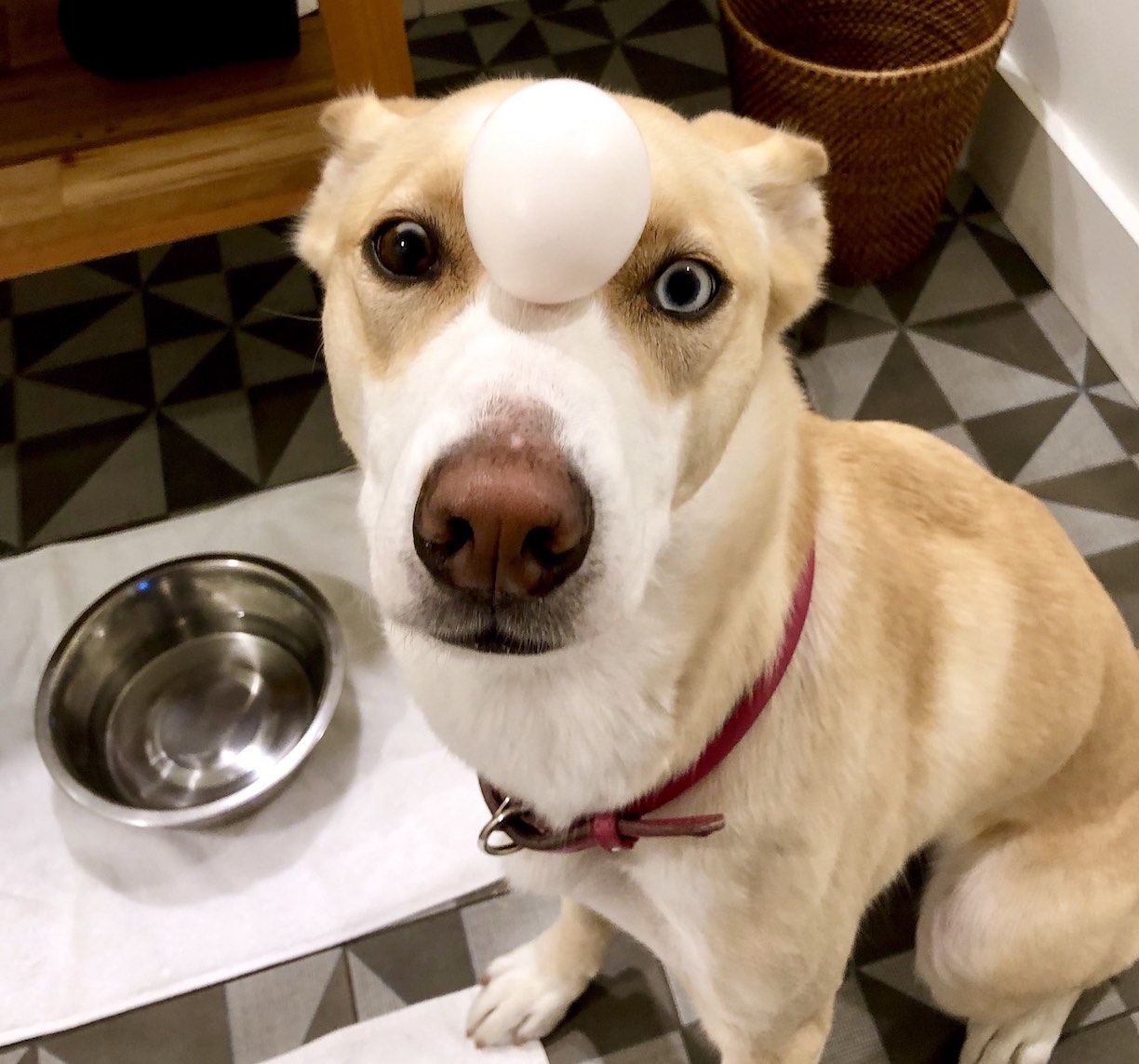
To help your husky burn off some energy and get the mental stimulation they require, Leslie has a few recommendations. First, you need the patience to train them. “With any puppy, you need lots of patience to be able to keep up with their destructive ways,” he says. “Huskies are known to be athletic working dogs, with a TON of energy. That being said, you need to practice both physical and mental stimulation.” Leslie recommends food puzzles, a flirt pole for outdoor play, and cites pet therapy as one of Astra’s biggest sources of mental stimulation. “Pet therapy is a great way for Astra to focus her energy in unique ways. Visiting and performing tricks is something that we both look forward to,” he says.
If possible, an ideal outdoor area for a husky would be accompanied by places to dig. If owners simply let their huskies outside to stave off boredom, they might find that their husky has either dug holes in the backyard or worse, escaped. Even if the yard is fenced in, Huskies are notorious escape artists, known for running away and the ability to leap tall fences.
Prey drive is another husky feature to keep in mind during training. “Her husky traits come out when we adventure,” says Leslie. “We love to go on trails and to the beach, but with those different terrains comes little creatures. Astra’s prey drive comes out and she will chase anything in the wild. Working on her ‘leave it’ and ‘come’ command allows her to regain focus and let the critter get away.”
Nutrition
Siberian huskies were bred to run maximum distances on minimal food. As modern companion animals, they are still known for their relatively small appetites despite their high activity levels. Your endurance athlete will do best on a high-quality dog food built from fresh, quality ingredients.
Food allergies and sensitivities are often responsible for skin problems in dogs. To diagnose and treat this, an elimination diet is typically implemented, which strictly controls the ingredients your dog is exposed to determine what might be causing issues (read more about elimination diets here).
Conventional highly processed canned wet food and dry kibble often contain unlisted ingredients on the label and include preservatives, artificial flavors and sub-par proteins like “chicken meal.” Misleading labels and poor-quality ingredients can exacerbate sensitive stomachs and inflame food allergies and sensitivities, thus making those conditions hard to control.
Recipes from The Farmer’s Dog are a great choice for huskies because the fresh, high-quality ingredients may help reduce this dog’s higher risk for digestion problems like inflammatory bowel disease, maintain a healthy skin, coat and weight, and support their high-energy, active lifestyle. As noted, fresh, whole foods can also provide important nutrients that are especially important to huskies. Husky owner Abe Libman says that his dog, Tyene, was developing characteristic symptoms of zinc deficiency when he brought her home. “Her pressing need for more zinc and my desire for a tidier alternative to raw meat led me to seek out The Farmer’s Dog in the first place,” he says of his choice to feed his husky fresh food.
The Farmer’s Dog recipes are developed with veterinarians to ensure correct proportions of protein, fat, and carbohydrates, and plans are tailored to meet each dog’s unique nutritional requirements. To make mealtime simple, recipes come precisely portioned to ensure your dog consumes the right number of calories per day to stay fit.
If you think you’d like a husky in your life, check out a husky rescue, or other animal shelter near you. The adorable duo pictured near the top of this post are a bonded pair available for adoption (at press time) from Lucky Husky in Arizona.
This article was vetted by a vet.
Reviewed by:
Deepti Johar, DVM.
Top photo by Tadeusz Lakota on Unsplash.
